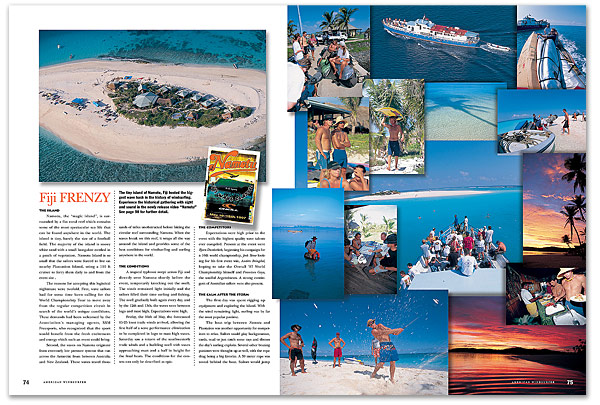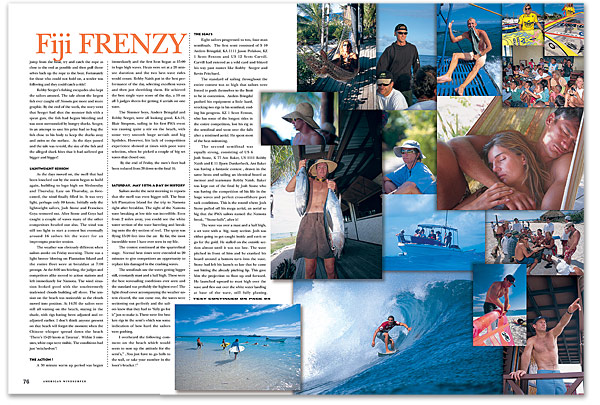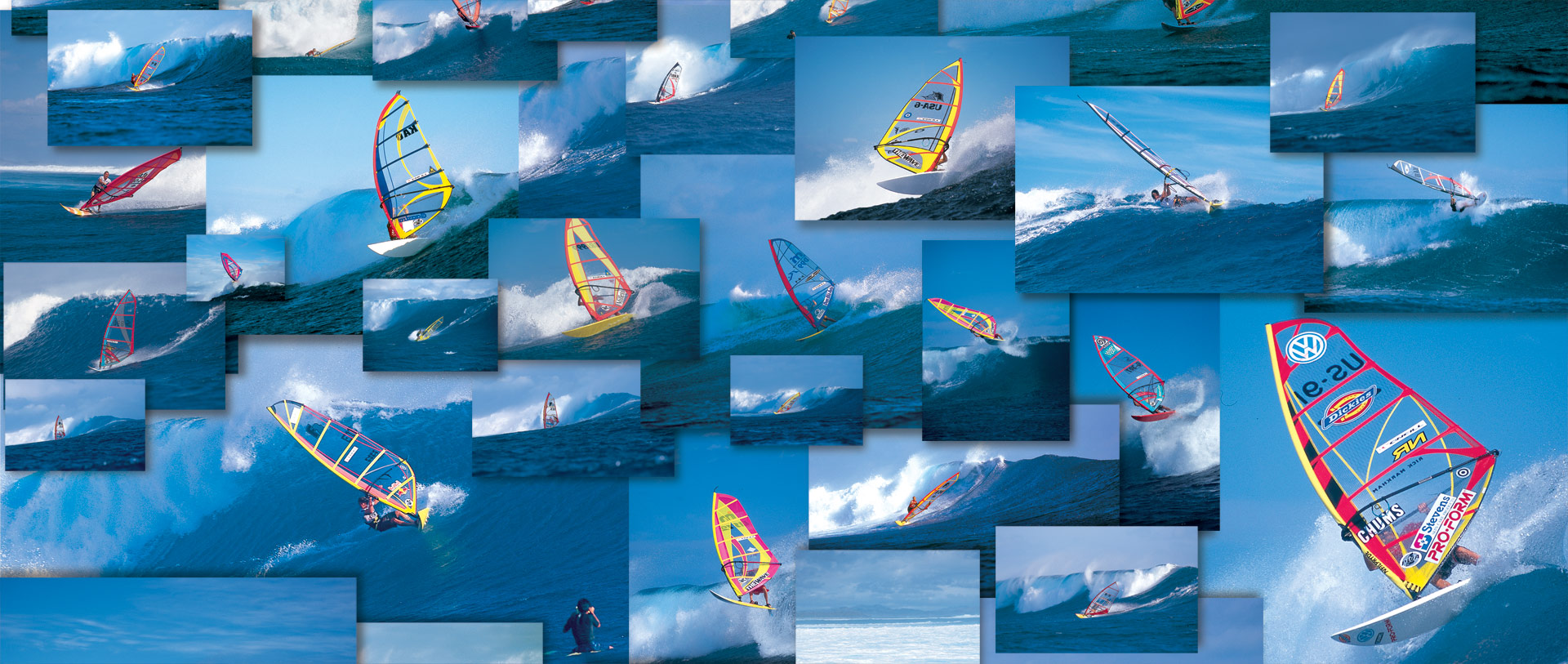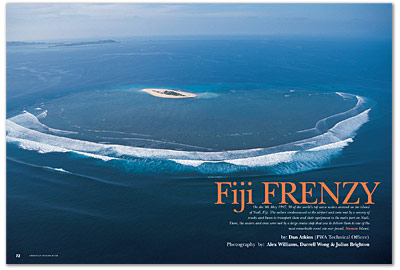On the 9th May 1997, 50 of the world’s top wave sailors arrived on the island of Nadi, Fiji. The sailors rendezvoused at the airport and were met by a convoy of trucks and buses to transport them and their equipment to the main port on Nadi. There, the sailors and crew were met by a large cruise ship that was to deliver them to one of the most remarkable event site ever found, Namotu Island.
The Island
Namotu, the “magic island”, is surrounded by a flat coral reef which contains some of the most spectacular sea life that can be found anywhere in the world. The island is tiny, barely the size of a football field. The majority of the island is snowy white sand with a small bungalow nestled in a patch of vegetation. Namotu Island is so small that the sailors were forced to live on nearby Plantation Island, using a 110 ft cruiser to ferry them daily to and from the event site .
The reasons for accepting this logistical nightmare were twofold. First, wave sailors had for some time been calling for the World Championship Tour to move away from the regular competition circuit in search of the world’s unique conditions. These demands had been welcomed by the Association’s managing agents, SSM Freesports, who recognized that the sport would benefit from the fresh excitement and energy which such an event could bring.
Second, the waves on Namotu originate from extremely low pressure systems that run across the Antarctic from between Australia and New Zealand. These waves travel thousands of miles unobstructed before hitting the circular reef surrounding Namotu. When the waves break on this reef, it wraps all the way around the island and provides some of the best conditions for windsurfing and surfing anywhere in the world.
The Conditions
A tropical typhoon swept across Fiji and directly over Namotu shortly before the event, temporarily knocking out the swell. The winds remained light initially and the sailors filled their time surfing and fishing. The swell gradually built again every day, and by the 12th and 13th, the waves were between logo and mast high. Expectations were high.
Friday, the 16th of May, the forecasted 15-25 knot trade winds arrived, allowing the first half of a wave performance elimination to be completed in logo to mast high waves. Saturday saw a return of the southwesterly trade winds and a building swell with waves approaching mast and a half in height for the final heats. The conditions for the contest can only be described as epic.
Advertisement

The tiny island of Namotu, Fiji hosted the biggest wave bash in the history of windsurfing. Experience the historical gathering with sight and sound in the newly release video “Namotu” See page 98 for further detail.
The Competitors
Expectations were high prior to the event with the highest quality wave talents ever compiled. Present at the event were Bjorn Dunkerbeck, beginning his campaign for a 10th world championship, Josh Stone looking for his first event win, Anders Bringdal, hoping to take the Overall ‘97 World Championship himself and Francisco Goya, the soulful Argentinean. A strong contingent of Australian sailors were also present.
The Calm After the Storm
The first day was spent rigging up equipment and exploring the island. With the wind remaining light, surfing was by far the most popular pastime.
The boat trip between Namotu and Plantation was another opportunity for competitors to relax. Sailors would play backgammon, cards, read or just catch some rays and discuss the day’s surfing exploits. Several other boating pastimes were thought up as well, with the rope drag being a big favorite. A 30 meter rope was towed behind the boat. Sailors would jump from the boat, try and catch the rope as close to the end as possible and then pull themselves back up the rope to the boat. Fortunately for those who could not hold on, a tender was following and they could catch a ride!
Robby Seeger’s fishing escapades also kept the sailors amused. The tale about the largest fish ever caught off Namotu got more and more graphic. By the end of the week, the story went that Seeger had shot the monster fish with a spear gun, the fish had begun bleeding and was soon surrounded by hungry sharks. Seeger, in an attempt to save his prize had to hug the fish close to his body to keep the sharks away and swim to the surface. As the days passed and the tale was re-told, the size of the fish and the alleged shark bites that it had suffered got bigger and bigger!
Lightweight Session
As the days moved on, the swell that had been knocked out by the storm began to build again, building to logo high on Wednesday and Thursday. Late on Thursday, as forecasted, the wind finally filled in. It was very light, perhaps only 10 knots. Initially only the lightweight sailors, Josh Stone and Francisco Goya ventured out. After Stone and Goya had caught a couple of waves many of the other competitors headed out also. The wind was still too light to start a contest but eventually around 16 sailors hit the water for an impromptu practice session.
The weather was obviously different when sailors awoke on Friday morning. There was a light breeze blowing on Plantation Island and the entire fleet were at breakfast at 7:00 prompt. At the 8:00 am briefing, the judges and competitors alike moved to action stations and left immediately for Namotu. The wind situation looked good with the southwesterly tradewind clouds building off shore. The tension on the beach was noticeable as the clouds moved into position. At 14:30 the sailors were still all waiting on the beach, staying in the shade, with rigs having been adjusted and re-adjusted earlier. I don’t think anyone present on that beach will forget the moment when the Chinese whisper spread down the beach ‘There’s 15-20 knots at Tavarua’. Within 5 minutes, white caps were visible. The conditions had just ‘switched-on’!

The Action !
A 30 minute warm up period was begun immediately and the first heat began at 15:00 in logo high waves. Heats were set at a 20 minute duration and the two best wave rides would count. Robby Naish put in the best performance of the day, selecting excellent waves and then just shredding them. He achieved the best single wave score of the day, a 10 on all 5 judges sheets for getting 4 aerials on one wave.
The Simmer boys, Anders Bringdal and Robby Seeger, were all looking good. KA-19, Blair Simpson, sailing in his first PWA event was causing quite a stir on the beach, with some very smooth huge aerials and big lipslides. However, his lack of competition experience showed at times with poor wave selection, when he picked a couple of big set waves that closed out.
By the end of Friday, the men’s fleet had been reduced from 38 down to the final 16.
Saturday, May 18th: a Day in History
Sailors awoke the next morning to reports that the swell was even bigger still. The boat left Plantation Island for the trip to Namotu right after breakfast. The sight of the Namotu wave breaking at low tide was incredible. Even from 2 miles away, you could see the white water section of the wave barreling and breaking onto the dry section of reef. The spray was flying 15-20 feet into the air. By far, the most incredible wave I have ever seen in my life.
The contest continued at the quarterfinal stage. Normal heat times were extended to 20 minutes to give competitors an opportunity to replace kits damaged in the crashing waves.
The semifinals saw the waves getting bigger still, constantly mast and a half high. These were the best wavesailing conditions ever seen and the standard was probably the highest ever! The light cloud cover accompanying the weather system cleared, the sun came out, the waves were sectioning out perfectly and the sailors knew that they had to “fully go for it” just to make it. There were five broken rigs in the semi’s which was some indication of how hard the sailors were pushing.
I overheard the following comment on the beach which would seem to sum up the attitude for the semi’s,” ..You just have to go balls to the wall, or take your number in the loser’s bracket !”
The Semi’s
Eight sailors progressed to two, four man semifinals. The first semi consisted of S 10 Anders Bringdal, KA 1111 Jason Polakow, KZ 1 Scott Fenton and US 12 Scott Carvill. Carvill had entered as a wild card and blitzed his way past names like Robby Seeger and Kevin Pritchard.
The standard of sailing throughout the entire contest was so high that sailors were forced to push themselves to the limit to be in contention. Anders Bringdal pushed his equipment a little hard, wrecking two rigs in his semifinal, ending his progress. KZ 1 Scott Fenton, who has some of the longest rides in the entire competition, lost his rig in the semifinal and went over the falls after a mistimed aerial. He spent most of the heat swimming.
Advertisement
The second semifinal was equally strong, consisting of US 6 Josh Stone, K 77 Ant Baker, US 1111 Robby Naish and E 11 Bjorn Dunkerbeck. Ant Baker was having a fantastic contest , drawn in the same heats and sailing an identical board as mentor and teammate Robby Naish. Baker was kept out of the final by Josh Stone who was having the competition of his life in the huge waves and perfect cross-offshore port tack conditions. This is the round where Josh Stone pulled off his mega aerial, an aerial so big that the PWA sailors named the Namotu break, “‘Stone-balls”, after it!
The wave was over a mast and a half high, a set wave with a big, nasty section. Josh was either going to get caught inside and eat-it or go for the gold. He stalled on the outside section almost until it was too late. The wave pitched in front of him and he cranked his board around a bottom turn into the wave. Stone had left his launch so late that he came out hitting the already pitching lip. This gave him the projection to float up and forward. He launched upward to mast high over the wave and flew out over the white water landing at base of the wave, still fully planing. Fortunately, he was planing enough to pull his rig from the white water that was rapidly catching him. As soon as he knew he’d made it he started screaming, he screamed all the way until he had finished riding the wave. All the judges were screaming too!
It was arguably the most stunning display of wave sailing ever seen in a PWA competition. Naish also progressed to the final to meet up with Stone, Carvill and Polakow for the ultimate showdown.
Women
The conditions for the women’s heats were very similar to those seen in the semi finals for the men. They rose to the challenge, went out and rode the waves like never before. The results are some of the finest display of women’s wave sailing ever seen.
KA-191 Jane Seman and US-6 Kelly Moore were really going for it in the first semi. They dominated the heat getting big aerials and sailing the biggest set waves right in the pocket, under the pitching lip.
In the second women’s semifinal, G-680 Jutta Mueller and KZ-15 Barbara Kendall progressed. Jutta had a really bad start to her semi. She went for a big aerial off the lip and landed on the back of the breaking wave. She recovered well with a couple of really nice rides toward the end of the heat. Olympic silver medallist Barbara Kendall sailed a really hard heat, pushing the whole time. She was almost barreled at one point when she was sailing right under the pitching lip.
The Women’s Final
KA-191 Jane Seman, G-680 Jutta Mueller, KZ-15 Barbara Kendall, US-6 Kelly Moore
With bigger waves and more wind the face of the wave became choppier. Barbara Kendall dominated again, although mainly on her wave riding. The waves were almost too big to get big aerials, which played into Kendall’s hands rather than Kelly Moore or Jane Seman. All four women impressed the judges and the other sailors with really tidy lip slides and drop aerials. The final decision placed Barbara Kendall first, with Kelly Moore in second.
The Men’s Final
US-1111 Robby Naish, KA-1111 Jason Polakow, US-12 Scott Carvill, USA-6 Josh Stone
With the swell continuing to build and waves approaching twice mast height, two different styles of wave riding prevailed in the final.
Of the four riders in the final, there were two very different approaches. Jason and Robby had a controlled recklessness on their aerials and really concentrated on carving up the waves, staying in the pocket of the wave and scoring highly for performing maneuvers in the critical section. Consequently, both Robby and Jason rode approximately 16 waves in the lengthened, 30 minute heat with 3 waves counting. Scotty and Josh’s approach to the lengthened heat duration was that it would allow them to approach the heat with total disregard for human safety! They both had the attitude that 30 minutes would easily give them time to replace wrecked equipment and get three waves to count. Both sailors went for the big-move approach and just went for full-on ‘make it or die’ style aerials. This really worked out for Carvill who got the biggest aerial of the final. By the end of the heat, Scott and Josh had only managed 6-8 waves in comparison to 16 by Robby and Jason.
The longer the heat went on, the more the two styles of sailing evened out. The three sailors’ wave scores closed in to within 1 point of each other. However, with the bigger wave conditions and slightly less opportunity for killer aerials, it was Robby Naish who stood out. Robby caught some of the biggest set waves ever seen in a windsurfing contest and took some of the longest rides.
The decision went to Robby Naish, with newcomer Scott Carvill second. The judges scored Jason Polakow third and Josh Stone fourth, although both sailors will receive joint third under the PWA ranking rules.
The Final Day
The final day of competition saw smaller, logo high waves and lighter winds. Although conditions were nowhere near as epic as the previous day, conditions were definitely suitable and Head Judge, Klaus Michel, gave the go ahead to start the double elimination. There was enough time to run 13 heats of the double elimination, allowing the 22 sailors eliminated on the first day to get a second chance to reach the top 16, not to mention a second chance to sail the Namotu wave!
All the sailors were stoked with the contest; from those who eliminated in the first round right though to those who made the final. The consensus was that the cost and trouble of holding the PWA O’Neill Wave Special in Fiji had paid off with one of the highest caliber wave fleets ever assembled for possibly the most spectacular competition on the history of the sport.
Dan Atkins runs around the world giving all the PWA event a sense of quality control.



 On the 9th May 1997, 50 of the world’s top wave sailors arrived on the island
On the 9th May 1997, 50 of the world’s top wave sailors arrived on the island